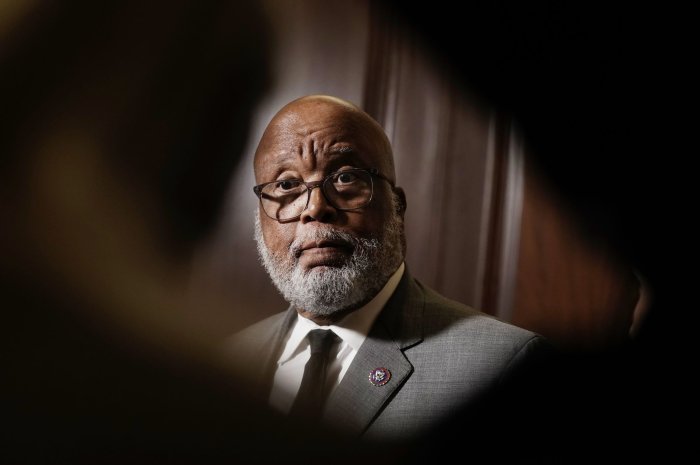A video of former President Donald Trump is seen on a screen as the House select committee investigating the Jan. 6 attack on the U.S. Capitol holds a public hearing to discuss its findings of a year-long investigation on Monday. Pool Photo by Mandel Ngan/UPI |
License Photo
What might future historians conclude about the tragic state of America today and describe how the nation got here? Three dates may answer this question.
Following Japan's surprise attack on Pearl Harbor, President Franklin Roosevelt called Dec. 7, 1941, "a day of infamy." Today, three dates might qualify as modern "days of infamy." The first is Aug. 7, 1964; the next Dec. 12, 2000; and last is Jan. 6, 2021.
Aug. 7 began the erosion of trust and confidence in government. Dec. 12 would make this crisis of legitimacy irreversible for decades. And Jan. 6 was the culmination of these forces cynically deforming the most trenchant sentence in the Declaration of Independence: "When government becomes destructive, it is the right of the people to alter or abolish it and establish a new one."
On Aug. 2, 1964, the destroyer USS Maddox on patrol in international waters off the North Vietnamese coast was attacked by North Vietnamese patrol boats. Maddox suffered a single bullet hole; several North Vietnamese PT boats were damaged; and four sailors were killed. Two days later, Maddox and the destroyer USS Turner Joy resumed the DeSoto patrols in the Gulf. Both reported a second attack by the North Vietnamese.
There was no second attack. However, President Lyndon Johnson seized the opportunity and asked Congress to approve what became the Tonkin Gulf Resolution. Only two members of the Senate and none in the House dissented. The United States slipped into the Vietnam War quagmire. At that point, about 75-80% of the public trusted and had confidence in the U.S. government.
Today, that percentage has been reversed. Not only has government been delegitimized. Virtually every institution from the media, corporations and law to the Boy Scouts and clergy has been discredited.
On Dec. 12, 2000, by a 5-4 vote along party lines, the Supreme Court stopped the presidential recount vote in Florida, awarding the election to George W. Bush, defeating Vice President Al Gore by 532 votes. On election night, Bush conceded defeat and then reversed his concession. Gore won the popular vote and, had the recount continued, could have been the winner.
The court's decision could have imploded the country had Gore not graciously conceded the election to Bush. However, the damage was done. Trust in the court was weakened. Over time and surely with the leak of the draft decision on Roe vs. Wade in May, the legitimacy of the court was impugned and challenged.
The culmination of these two days of infamy was Jan. 6, 2021 and the storming of the Capitol building. The hearings of the House of Representatives Select Committee are revealing heretofore unreleased material that underscores the repulsive conduct of then-President Donald Trump and raises the question of whether he should be indicted for inciting an attempted coup.
Despite the absence of any evidence supporting what Democrats call the "big lie," Trump still persists in wrongly insisting he won a landslide victory and the election was stolen. And that falsehood is stunningly accepted by a majority of registered Republicans.
Democrats are using these hearings as a "third impeachment" trial of Trump. However, the hearings will only intensify the overheated animosities and even hatred between the two parties. More worrying, two profoundly difficult and thus far latent issues have surfaced that are further assaults on the Constitution and the nation.
Two impeachment trials charged the president with "high crimes and misdemeanors," the second over the Jan. 6 riots. The Senate acquitted him in both cases. But does that raise the issue of double jeopardy and the prohibition against being tried for the same crime twice? It would seem that all or most crimes were covered under those impeachment charges.
Next, suppose a president has legitimate grounds for challenging election results. Richard Nixon and Gore certainly did: Nixon over voter fraud in Cook County, Ill., and West Virginia and Gore over Florida. Both conceded, allowing a peaceful transition of power.
What are the legal and constitutional grounds that support or restrict contesting elections by a losing nominee? None are clear. But a political Pandora's Box has been opened. Americans have lost so much confidence in so many institutions, particularly government, to obscure any righting force that could bring the nation together.
With a past president possibly to be indicted of a crime and the current one, according to a majority of Americans, unsuccessfully grappling with the nation's ills, how bleak the future looks. This may not be 1861. But, on the current trajectory, it could come close.
Harlan Ullman is senior adviser at Washington's Atlantic Council, the prime author of "shock and awe" and author of "The Fifth Horseman and the New MAD: How Massive Attacks of Disruption Became the Looming Existential Danger to a Divided Nation and the World at Large." Follow him @harlankullman.
The views and opinions expressed in this commentary are solely those of the author.
Committee Chairman Bennie Thompson, D-Miss., speaks to reporters after the House select committee investigating the Jan. 6 attack on the U.S. Capitol held its second public hearing to discuss its findings of a year-long investigation, on Capitol Hill in Washington, D.C., on June 13, 2022. Photo by Ken Cedeno/UPI |
License Photo
















